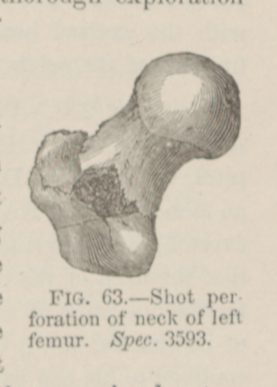Title: Boyle, Peter
Source text: The Medical and Surgical History of the War of the Rebellion. (1861-65.), Part 3, Volume 2 (Washington, DC: Government Printing Office, 1883), 108-109.
Civil War Washington ID: med.d2e5632
TEI/XML: med.d2e5632.xml
CASE 254.—Private Peter Boyle, Co. D, 59th Massachusetts, aged 60 years, was wounded at Petersburg, July 30, 1864. A conoidal musket ball entered the left hip and passed antero-posteriorly through the soft parts and surgical neck of the femur, and fractured the trochanter major. His entry at the base hospital at City Point and transfer to Washington are recorded on August 1st. He was conveyed to Washington on an hospital steamer, and on August 3d was admitted to Douglas Hospital. His constitutional condition, on admission, was poor. The wound, however, had an healthy aspect, and a thorough exploration showed that the injury to the soft tissues involved no important part, and that the fracture at the junction of the neck and trochanter major was not accompanied by much longitudinal splintering in either direction. Assistant Surgeon William Thomson, U. S. A., decided that an excision of the injured bone was expedient, and that the operation should be done as soon as the patient had rallied from the fatigue and irritability induced by his long journey. On August 5th, ether having been administered, Assistant Surgeon Thomson proceeded to excise the head, neck, and trochanters of the left femur, through a straight incision of sufficient length made over the trochanter major. The rotator muscles and the tendons of the psoas and iliacus being divided, the round ligament was readily cut and the head exarticulated. The section of the shaft was made by a chain saw at the level of the trochanter minor. The operation was rapidly accomplished, and there was no hæmorrhage of moment. The wound was dressed with an antiseptic solution of one drop of creasote to each ounce of water on charpie, and the limb was supported by a sand bag on either side. The patient reacted well after the operation; but at night there was profuse sweating and some nausea. On the following morning he ate a good breakfast. He still had a cool, sweating skin, and his pulse was at 128. He gradually sank, and died from exhaustion on August 7, 1864. The pathological preparation, presented by Dr. Thomson to the Army Medical Museum, is figured by the accompanying wood-cut (FIG. 63).
